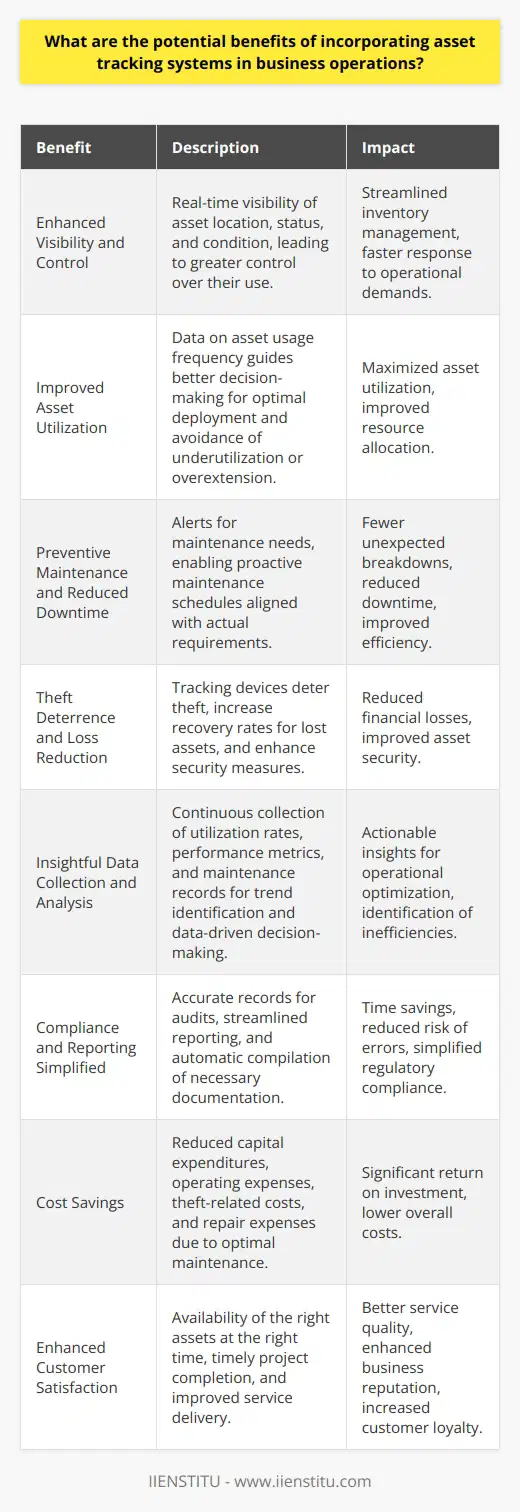Asset tracking is a quintessential component of modern business operations that anchors the foundation of asset management strategies. Characterized by its ability to signify the exact location and status of assets, it serves an instrumental role across a sundry of sectors—ranging from manufacturing to retail, and healthcare to logistics.
Given the burgeoning complexity of supply chains and the escalating value of assets, comprehending the role and mechanics of asset tracking is not merely an auxiliary skill but a critical necessity. It stands at the crossroads of operational efficiency and financial acuity, informing decision-making processes and underpinning cost-saving initiatives.
Therefore, understanding the concept of asset tracking, its deployment in various industries, and grasping the broad spectrum of its benefits and implications in business operations is critical for ensuring strategic advantage and sustainable success.
Understanding the Fundamentals of Asset Tracking
Defining Asset Tracking: What is it?
Asset tracking is an intricate process of monitoring the location, usage, and status of assets, which refers broadly to any valuable items, resources, or properties owned by a company. Its principal function is to provide a systematic approach for recording and managing assets throughout their lifecycle, ensuring accountability and efficient resource allocation.
This detailed description encapsulates not only physical assets like machinery, equipment, and inventory but also intangible assets such as licenses and patents.
Asset tracking can manifest in various modalities, contingent upon the nature and characteristics of the assets at hand. Tangible assets often necessitate more tactile forms of tracking, leveraging tools like barcodes and RFID tags, while intangible assets may be managed through digital registries and databases that record usage rights and expirations.
In all cases, the goal remains the same: to establish an organized system that ensures assets are utilized optimally and protected effectively.
Reason for the Existence of Asset Tracking
Asset tracking exists as a lynchpin for businesses and organizations, pivotal to the safeguarding of assets and the maximization of their value. It addresses various logistical and operational challenges, including the prevention of asset loss, theft, and misuse. The significance of asset tracking to businesses is pronounced in sectors where the precise coordination of numerous assets is vital for everyday operations.
By turning the spotlight on real-world scenarios, one can observe the transformative impact of effective asset tracking. Hospitals use asset tracking to maintain critical medical equipment, manage supplies, and optimize patient care.
Similarly, in the realm of logistics certification courses, asset tracking is a prominent topic, demonstrating the importance of keeping tabs on fleet vehicles and transported goods. Synergy between theoretical knowledge and practical application is thus essential, providing professionals with comprehensive capabilities to navigate complex logistical terrains.
The Technology Behind Asset Tracking
Exploration of Various Asset Tracking Technologies
Asset tracking is underpinned by myriad technological innovations designed to simplify and streamline the process of asset management. Among them, RFID (Radio Frequency Identification) Technology emerges as a dominant force, characterized by its use of electromagnetic fields to automatically identify and track tags attached to objects. This technology excels in environments where swift and seamless scanning is key to operational efficiency, such as in large distribution centers.
GPS (Global Positioning System) Technology offers the advantage of real-time tracking with global coverage, which is invaluable for managing mobile assets like shipping containers and vehicles. The immense utility of GPS is evident in its adoption by various entities that necessitate constant visibility over their assets regardless of geographical constraints.
The Internet of Things (IoT) Technology further expands the horizons of asset tracking by embedding interoperable devices within a cohesive network, fostering a new echelon of intelligence and automation. IoT devices can provide comprehensive data regarding the condition and performance of assets, engendering proactive maintenance and heightened operational insight.
Lastly, Barcode Technology retains its prominence due to its simplicity and cost-effectiveness. Despite the advent of more sophisticated technologies, barcodes remain pervasive, especially in retail and warehousing, buoyed by their ease of use and universal applicability.
Comparison of the Different Technologies and Their Suitability in Various Contexts
Conducting a detailed comparative analysis of these technologies reveals their unique adequacies and constraints when applied to diverse contexts. RFID, for instance, offers the benefit of scanning multiple items simultaneously without line-of-sight, which is less feasible with barcode technology. Conversely, GPS is unrivaled in geolocating assets but could prove less practical for indoor tracking where RFID and barcodes may excel.
Examples abound, illustrating the strategic deployment of these technologies based on context. Consider a logistics provider that integrates GPS for route optimization of its fleet and RFID for inventory management within warehouses. Or a library system utilizing barcodes for book checkouts due to the low cost and ease of dissemination. The decision matrix that leads to selecting the appropriate asset tracking technology involves a blend of financial, operational, and strategic considerations, all critical to the desired outcomes.
Challenges and Solutions in Asset Tracking
Highlighting the Common Challenges in Asset Tracking
Despite its pivotal role, asset tracking is not devoid of challenges that can impede its effectiveness. Technical challenges, such as the implementation and integration of tracking systems into the existing IT infrastructure, can present considerable hurdles, potentially thwarting the real-time and accurate data collection necessary for judicious asset management.
Operational challenges further compound these difficulties, particularly when tracking assets across vast areas or when mobile assets are involved. The handling of large volumes of data generated by tracking systems can also strain resources, requiring specialized knowledge and robust data management practices to ensure its utility is capitalized on.
Presenting the Possible Solutions to These Challenges
In the face of these challenges, solutions are emerging, driven by relentless advances in technology. The advent of cloud computing and improved data analytics has facilitated the seamless integration of asset tracking data into broader business intelligence frameworks. This integration enables more responsive decision-making, leveraged on comprehensive insights drawn from a holistic view of assets.
Real-life organizational scenarios affirm the effectiveness of these advances in overcoming asset tracking challenges. For example, companies that specialize in online courses have devised platforms that efficiently track digital assets such as course content and user progress. Concurrently, advancements in IoT and networking allow for better tracking and maintenance of hardware assets that are part of the educational technology infrastructure.
Future Perspectives on Asset Tracking
Look into Future Trends in Asset Tracking
Foreseeing future trends in asset tracking involves recognizing the potential imbued within emergent technologies such as AI, Machine Learning, and Big data. These technologies are poised to revolutionize asset tracking by enabling predictive analytics, which forecasts potential issues before they materialize, and by refining the precision of tracking systems through adaptive learning algorithms.
Cross-industry applications are set to multiply, as sectors that previously may not have leveraged asset tracking to its full potential begin to realize its pivotal role in bolstering efficiency and competitiveness. Industries such as agriculture, education, and public administration stand to gain significantly from adopting advanced asset tracking solutions, thereby catalyzing sustainability and innovation.
Anticipated Challenges and Opportunities in the Future of Asset Tracking
Despite the promise these future trends hold, potential roadblocks related to the adoption of new technologies persist. Issues such as data privacy, cybersecurity, and the requisite adjustment in corporate culture can deter the implementation of cutting-edge asset tracking systems.
But, where challenges loom, so do opportunities. The scope for growth in asset tracking is vast, with untapped markets and novel applications continuing to surface. As organizations strive toward an interconnected and digitized operational landscape, asset tracking remains a cornerstone for future advancements—a harbinger of more resilient, intelligent, and optimized management of assets.
To recapitulate, asset tracking stands as a central tenet of modern business operations. It empowers enterprises to manage resources with greater visibility, efficiency, and control. From the specifics of implementing tracking technologies to navigating through the challenges it presents, asset tracking is undeniably complex yet undeniably necessary.
Looking forward, staying abreast of evolving trends and technological developments in asset tracking is not a luxury but an imperative for businesses aiming to garner the fullest benefits. As businesses wade into the ever-expanding digital terrain, the strategic value of asset tracking escalates, becoming an indispensable element for future-proofing operations and sustaining a competitive advantage in the dynamic business landscape of tomorrow.
Frequently Asked Questions
What are the potential benefits of incorporating asset tracking systems in business operations?
Introduction to Asset Tracking Systems
Asset tracking systems play a critical role in business operations. These solutions allow companies to monitor physical assets. They track their location, status, and condition. Several potential benefits arise from their use.
Benefits of Asset Tracking Systems
Enhanced Visibility and Control
Asset tracking ensures real-time visibility of assets. This leads to greater control over their use. Managers can locate items quickly. They can respond faster to operational demands. These systems thus streamline inventory management.
Improved Asset Utilization
Organizations can maximize asset utilization through tracking. Data from these systems indicates how often assets see use. This information guides better decision-making. Companies can optimize asset deployment. They avoid underutilization or overextending resources.
Preventive Maintenance and Reduced Downtime
Tracking systems alert businesses to maintenance needs. They signal when assets require service. This proactiveness prevents unexpected breakdowns. It results in less downtime. Maintenance schedules align with actual needs. Efficiency improves.
Theft Deterrence and Loss Reduction
Asset tracking deters theft. It locates lost items. The presence of tracking devices discourages potential theft. Recovery rates for misplaced assets increase. Financial losses drop. The business benefits from enhanced security measures.
Insightful Data Collection and Analysis
Tracking systems collect data continuously. They gather utilization rates, performance metrics, and maintenance records. Analysis of this data yields actionable insights. Companies can identify trends and inefficiencies. They can make data-driven decisions to optimize operations.
Compliance and Reporting Simplified
Many businesses face regulatory requirements. Asset tracking systems streamline compliance. They provide accurate records for audits. Reporting becomes less burdensome. The systems automatically compile necessary documentation. Businesses thus save time and reduce error risks.
Cost Savings
Effective asset tracking cuts costs. It reduces capital expenditures and operating expenses. Misplaced items receive quicker replacement. Theft-related costs reduce. Optimal maintenance lowers repair expenses. Businesses see a significant return on investment.
Enhanced Customer Satisfaction
Finally, asset tracking impacts the customer. It ensures the right assets are available at the right time. Projects complete on schedule. Service quality improves. Customers experience better service delivery. This enhances the business's reputation and boosts customer loyalty.
In conclusion, asset tracking systems offer multiple benefits. They enhance operational efficiency and asset management. Businesses see cost reductions and improved service quality. Asset tracking remains an essential component of modern business strategy. It fosters a proactive approach to managing valuable resources.

How does asset tracking contribute to better decision-making and optimizing the use of resources in a business environment?
Understanding Asset Tracking
Asset tracking forms a crucial part of resource management. It involves monitoring the assets of a business. These assets include tools, equipment, and valuable items. Technology aids in this process significantly. Barcode labels, RFID tags, and GPS devices are common tools.
Impact on Decision-Making
Data drives modern decision-making. Asset tracking provides rich data sets. Managers rely on this data. They make more informed choices. The data reflects asset usage and performance. Also, it highlights maintenance needs. Multiple business areas benefit from precise data.
Better asset management leads to cost savings. Companies identify under-used or redundant assets. They reallocate or dispose of these efficiently. Thus, businesses optimize asset portfolios. This results in a leaner operation.
Risk mitigation is another advantage. Managers foresee issues with asset health. They take proactive measures. Therefore, sudden breakdowns diminish. Productivity does not suffer unexpected hits.
Optimizing Resources
Asset tracking boosts resource optimization. It ensures equipment is available where needed. Also, it prevents overstocking or shortages. Inventory levels remain precise. Companies save on storage costs.
Lifecycle management improves with tracking. Businesses track the lifespan of assets. They plan for replacements in advance. Consequently, they avoid last-minute rush purchases.
Energy consumption decreases. Efficient asset deployment leads to less waste. Companies use assets with better energy ratings. Asset health monitoring also curtails energy loss.
Asset tracking is not a luxury. It is a necessity for modern businesses. Strong tracking systems pave the way for better decisions. They also ensure optimal resource use. Companies grow more competitive with these practices. They achieve sustainability and robust financial health.

What are the possible implications on overall operational efficiency and productivity levels when a business adopts an asset tracking system?
Asset Tracking Enhances Operational Efficiency
When businesses introduce asset tracking systems, they typically aim to monitor resources more closely. These systems offer real-time data on asset location, status, and usage. They often trigger improvements across different operational levels. Initially, companies may notice a reduction in the time spent locating and managing assets. Employees no longer waste hours searching for equipment. Instead, they access location information instantly.
Real-time Data Drives Productivity
Tracking assets in real-time supports better decision-making. Managers view asset utilization, adjusting deployment strategies accordingly. They assign resources where needed most, preventing bottlenecks. This level of oversight culminates in heightened efficiency. Moreover, it ensures the most critical tasks receive the necessary tools without delay.
Reduced Loss and Theft
Asset tracking minimizes the risk of losing or stealing items. With continual monitoring, the likelihood of assets going missing drops significantly. Companies experience fewer disruptions due to misplaced or lost items. As a consequence, they save costs on replacement or recovery. These savings can redirect to other areas that boost productivity.
Improved Maintenance Schedules
Maintenance becomes more predictable with asset tracking. Systems often include maintenance alerts and schedules. It ensures timely upkeep of equipment, which reduces downtime. Well-maintained assets rarely malfunction. They thus uphold a seamless production line or service delivery.
Better Usage Insights Lead to Informed Purchases
Through usage data, organizations understand asset life cycles better. They identify which assets work hard and which lie idle. This data informs future purchasing decisions. Companies can invest in assets that offer the highest return on investment (ROI). It translates to smarter capital allocation.
Streamlined Inventory Management
Asset tracking integrates with inventory management systems. It provides precise counts of on-hand equipment and supplies. Managers maintain optimal inventory levels, minimizing excess or shortages. They match supply more accurately with demand. Efficient inventory management supports uninterrupted operations and maximum productivity.
Enhanced Customer Satisfaction
When businesses function smoothly, customer satisfaction often rises. This improves brand loyalty and paves the way for repeat business. With proper asset management, companies deliver on promises more consistently. They meet customers' expectations, elevating their market standing.
Compliance and Reporting Simplified
Compliance with industry standards becomes less cumbersome with asset tracking. Systems automatically log information necessary for audits and reporting. Companies then stay on top of regulatory demands with less effort. They allocate less time to compliance tasks and more to core business activities.
In summary, adopting an asset tracking system can profoundly affect a business's efficiency and productivity. This relatively simple change holds the potential to streamline operations. It makes them more effective and responsive to the needs of the business and its customers. The gains from saving time, reducing asset loss, improving maintenance, and enhancing decision-making can be substantial. They often result in a significant, positive impact on the company's bottom line.



